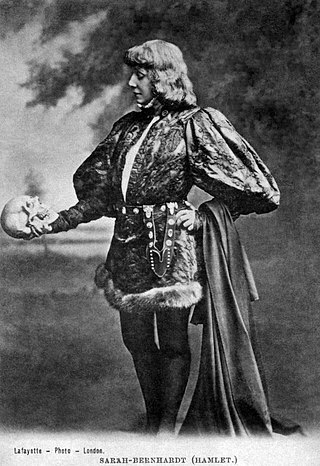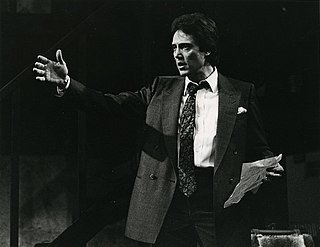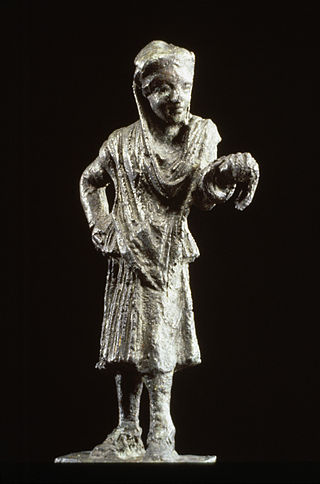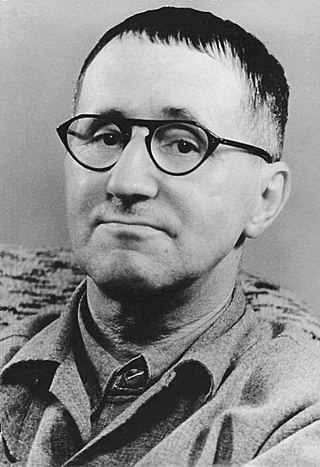Related Research Articles

Acting is an activity in which a story is told by means of its enactment by an actor who adopts a character—in theatre, television, film, radio, or any other medium that makes use of the mimetic mode.

The following outline is provided as an overview of and topical guide to theatre:

The fourth wall is a performance convention in which an invisible, imaginary wall separates actors from the audience. While the audience can see through this "wall", the convention assumes the actors act as if they cannot. From the 16th century onward, the rise of illusionism in staging practices, which culminated in the realism and naturalism of the theatre of the 19th century, led to the development of the fourth wall concept.

In theatre, a monologue is a speech presented by a single character, most often to express their thoughts aloud, though sometimes also to directly address another character or the audience. Monologues are common across the range of dramatic media, as well as in non-dramatic media such as poetry. Monologues share much in common with several other literary devices including soliloquies, apostrophes, and asides. There are, however, distinctions between each of these devices.

Stage combat, fight craft or fight choreography is a specialised technique in theatre designed to create the illusion of physical combat without causing harm to the performers. It is employed in live stage plays as well as operatic and ballet productions. With the advent of cinema and television the term has widened to also include the choreography of filmed fighting sequences, as opposed to the earlier live performances on stage. It is closely related to the practice of stunts and is a common field of study for actors. Actors famous for their stage fighting skills frequently have backgrounds in dance, gymnastics or martial arts training.
Diegesis is a style of fiction storytelling which presents an interior view of a world in which the narrator presents the actions of the characters to the readers or audience.

Ancient Greek theatre was a theatrical culture that flourished in ancient Greece from 700 BC. The city-state of Athens, which became a significant cultural, political, and religious place during this period, was its centre, where the theatre was institutionalised as part of a festival called the Dionysia, which honoured the god Dionysus. Tragedy, comedy, and the satyr play were the three dramatic genres to emerge there. Athens exported the festival to its numerous colonies. Modern Western theatre comes, in large measure, from the theatre of ancient Greece, from which it borrows technical terminology, classification into genres, and many of its themes, stock characters, and plot elements.

Epic theatre is a theatrical movement that arose in the early to mid-20th century from the theories and practice of a number of theatre practitioners who responded to the political climate of the time through the creation of new political dramas. Epic theatre is not meant to refer to the scale or the scope of the work, but rather to the form that it takes. Epic theatre emphasizes the audience's perspective and reaction to the piece through a variety of techniques that deliberately cause them to individually engage in a different way. The purpose of epic theatre is not to encourage an audience to suspend their disbelief, but rather to force them to see their world as it is.

Experimental theatre, inspired largely by Wagner's concept of Gesamtkunstwerk, began in Western theatre in the late 19th century with Alfred Jarry and his Ubu plays as a rejection of both the age in particular and, in general, the dominant ways of writing and producing plays. The term has shifted over time as the mainstream theatre world has adopted many forms that were once considered radical.

Shakespeare's plays are a canon of approximately 39 dramatic works written by English poet, playwright, and actor William Shakespeare. The exact number of plays as well as their classifications as tragedy, history, comedy, or otherwise is a matter of scholarly debate. Shakespeare's plays are widely regarded as being among the greatest in the English language and are continually performed around the world. The plays have been translated into every major living language.
Process drama is a method of teaching and learning drama where both the students and teacher are working in and out of role.
Metatheatre, and the closely related term metadrama, describes the aspects of a play that draw attention to its nature as drama or theatre, or to the circumstances of its performance. "Breaking the Fourth Wall" is an example of a metatheatrical device.

The architectural form of theatre in Rome has been linked to later, more well-known examples from the 1st century BC to the 3rd Century AD. The theatre of ancient Rome referred to a period of time in which theatrical practice and performance took place in Rome. The tradition has been linked back even further to the 4th century BC, following the state’s transition from monarchy to republic. Theatre during this era is generally separated into genres of tragedy and comedy, which are represented by a particular style of architecture and stage play, and conveyed to an audience purely as a form of entertainment and control. When it came to the audience, Romans favored entertainment and performance over tragedy and drama, displaying a more modern form of theatre that is still used in contemporary times.

Conceptualised by 20th century German director and theatre practitioner Bertolt Brecht (1898–1956), "The Modern Theatre Is the Epic Theatre" is a theoretical framework implemented by Brecht in the 1930s, which challenged and stretched dramaturgical norms in a postmodern style. This framework, written as a set of notes to accompany Brecht's satirical opera, ‘Rise and Fall of the City of Mahagonny’, explores the notion of "refunctioning" and the concept of the Separation of the Elements. This framework was most proficiently characterised by Brecht's nihilistic anti-bourgeois attitudes that “mirrored the profound societal and political turmoil of the Nazi uprising and post WW1 struggles”. Brecht's presentation of this theatrical structure adopts a style that is austere, utilitarian and remains instructional rather than systematically categorising itself as a form that is built towards a more entertaining and aesthetic lens. ‘The Modern Theatre Is the Epic Theatre’ incorporates early formulations of Brechtian conventions and techniques such as Gestus and the V-Effect. It employs an episodic arrangement rather than a traditional linear composition and encourages an audience to see the world as it is regardless of the context. The purpose of this new avant-garde outlook on theatrical performance aimed to “exhort the viewer to greater political vigilance, bringing the Marxist objective of a classless utopia closer to realisation”.

Museum theatre is the use of theatre and theatrical techniques by a museum for educational, informative, and entertainment purposes. It can also be used in a zoo, an aquarium, an art gallery, and at historic sites. It is generally performed by professional actors. Varieties of museum theatre include historical characters, puppetry, movement and music.

Drama is the specific mode of fiction represented in performance: a play, opera, mime, ballet, etc., performed in a theatre, or on radio or television. Considered as a genre of poetry in general, the dramatic mode has been contrasted with the epic and the lyrical modes ever since Aristotle's Poetics —the earliest work of dramatic theory.

Theatre or theater is a collaborative form of performing art that uses live performers, usually actors or actresses, to present the experience of a real or imagined event before a live audience in a specific place, often a stage. The performers may communicate this experience to the audience through combinations of gesture, speech, song, music, and dance. It is the oldest form of drama, though live theatre has now been joined by modern recorded forms. Elements of art, such as painted scenery and stagecraft such as lighting are used to enhance the physicality, presence and immediacy of the experience. Places, normally buildings, where performances regularly take place are also called "theatres", as derived from the Ancient Greek θέατρον, itself from θεάομαι.

A play is a form of drama that primarily consists of dialogue between characters and is intended for theatrical performance rather than mere reading. The creator of a play is known as a playwright.

Presentational acting and the related representational acting are opposing ways of sustaining the actor–audience relationship. With presentational acting, the actor acknowledges the audience. With representational acting, the audience is studiously ignored and treated as voyeurs.
The Theatre of the Grotesque was a twentieth-century dramatic movement. It is a theatrical style that was developed as a derivative to the late eighteenth-century art movement 'Grotesque' and thus translates the themes and images of the grotesque art into theatrical practices.
References
- ↑ Neelands, Jonothan; Goode, Tony (2008). Structuring drama work: a handbook of available forms in theatre and drama (2nd ed.). Cambridge, UK; New York, NY, US: Cambridge University Press. ISBN 978-0-521-78729-1.
- ↑ Booth, David (2005). Story Drama: Creating Stories Through Role Playing, Improvising, and Reading Aloud (2nd ed.). Markham, ON: Pembroke Publishers Limited. pp. 42–43. ISBN 9781551381923.